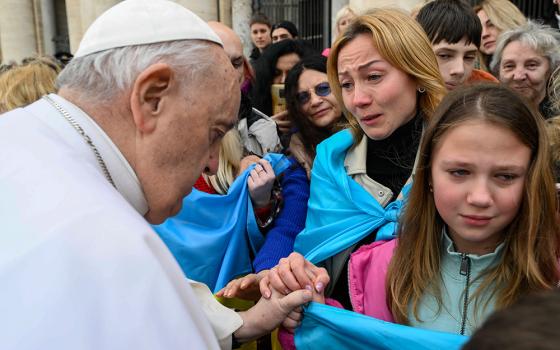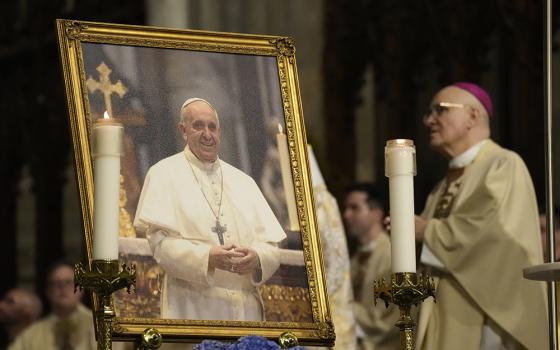Ann Sieben looks exactly like what you'd expect of a pilgrim.
Tanned skin and rosy cheeks are evidence of spending hours under the sun. If her boots could talk, they'd explain that the light coat of dust is from walking on a trail for weeks. Sieben's bright, big smile, though, is a tell-all of the energy and vibrancy it takes for a journey by foot to visit the places where an American saint once lived and worked.
Sieben and her friends, Roscoe Hill and Jim Adams, walked 335 miles in 25 days to experience the spirit of the journey of St. Rose Philippine Duchesne, who arrived in America in 1818 to establish schools in St. Louis with her community, the Society of the Sacred Heart.
The pilgrims started their journey in Mound City, Kansas, near where St. Rose Philippine prayed with the Potawatomi. They walked from Kansas into Missouri, eventually connecting with the western terminus of the Katy Trail in Clinton. Following the trail all the way to St. Charles, the pilgrimage ended May 18 at the Academy of the Sacred Heart, where the saint taught and her final resting place.
The trio's pilgrimage highlights a number of events planned by the Society of the Sacred Heart over the next several months to mark the bicentennial of the saint's arrival, including eucharistic celebrations, more pilgrimages, a spirituality forum and an online year of prayer that begins in November.
Sieben, 53, herself has planned two more pilgrimages for the spring and fall of 2018. She has made this her vocation as a consecrated layperson with the Society of Servant Pilgrims, but she had only heard of St. Rose Philippine a year ago.
"I'm from New Jersey," she said with a grin. But nevertheless, she recognized the historic importance of the anniversary of the saint's arrival and how she pioneered educating children in rough, frontier conditions.
"Part of the pilgrimage experience was really to connect with her experience," Sieben said. "The pilgrimage puts us in touch with the earth and the elements and what she was facing. We give up the comforts of home, and she had no comforts."
Saints and pilgrims go hand in hand, because of the journey that both experience, she explained.
"The saints are saints because they exercised heroic virtue in their lifetime," Sieben said. "They left examples for all of us of how they lived their day-to-day holy life. This is why saints and pilgrims go together. We (get to visit) a destination where the saint did their work, where they walked, and did these heroic, virtuous things."
Sieben placed two small booklets on a table. One was a long piece of card stock folded in sixths. It was filled with signatures and stamps of the places they stopped along the route. The other was a small booklet, inserted with three pieces of paper that unfolded, revealing list of anticipated places where they could stop.
These were the group's lifelines. The card stock acted as a passport, filled with the signatures of people they stayed with or visited along the way. They could show it to those in the next town when vying for a place to stay. It's something that pilgrims have used for more than 1,000 years and was the precursor to the national passport, Sieben explained.
"It's a pilgrim's credential," she explained. "I can say, 'Look, we're certified by the archbishop of Denver, and we're signed by the archbishop of Kansas City.'"
With Google Maps, Sieben sketched a route starting from Mound City, and heading east to Clinton, where they picked up on the Katy Trail. In that first stretch of 81 miles, "I just had to figure out where to go on the dirt roads, farm roads, and find churches and walk from church to church," she said.
Sieben has had more than a decade of experience with this. As a mendicant pilgrim -- one who dedicates her life to walking on pilgrimages, often going solo and carrying nothing of value — she started the Society of Servant Pilgrims under the approval of the Archdiocese of Denver. In 2016, the society became an official Association of the Christian Faithful under canon law.
The route didn't precisely follow St. Rose Philippine's steps, but the group stayed as authentically connected as possible by paralleling the Missouri River, and witnessing native prairie land as the saint would have seen it. They averaged about 13 miles a day. Sieben walked faster than the other two, so she would arrive at a town for the evening and look for someone to make arrangements to stay at a church for the night.
At several churches, the group found an image of Jesus knocking on a door — a sign of welcome to pilgrims. "When someone knocks on the door, you should treat them as Jesus," Sieben said. "I think, 'How many doors were opened to us with this spirit?'"
Three years ago, Sieben met Jim Adams at a national pilgrims' gathering at the Shrine of Our Lady of the Snows in Belleville, Illinois. Adams, 75, who attends Our Lady of Lourdes Parish in University City, had been interested in El Camino de Santiago in Spain, but never got to walk along the famed pilgrimage route.
Last year at the same gathering in Belleville, Adams told her about St. Rose Philippine Duchesne. He had been reading about the American saint — one of 10 American saints to be exact — and the bicentennial celebration in 2018.
Roscoe Hill, 80, met Sieben in Denver some years ago. He and his late wife, who about 10 years ago had walked El Camino de Santiago, were introduced to her through the friends sometime back and they kept in touch.
When he learned of her plans to go to Kansas and Missouri, he asked if he could come along.
The day they reached St. Charles, May 18, marked the 18-month anniversary since his wife had died.
Adams felt the benefits of doing a cross-state walking pilgrimage.
"Ninety percent of what we have to do with our brain is put out the other stuff," he said. "When you're walking by yourself like this and there's no industrial sound, no mad rat race going on all around you, it just opens you up. You don't have to spend all your energy taking all the distractions away. When you get used to the blisters and other inconveniences, you get in a rhythm and it's very restful. It made me appreciate walking. I might do this again."
More information about upcoming bicentennial events, including how to make a similar pilgrimage, is available at rscj.org/bicentennial2018. Information about the Society of Servant Pilgrims is available at www.societyofservantpilgrims.com



